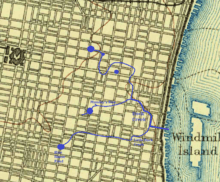Dock Creek

Dock Creek was a stream draining much of what is now the eastern half of Center City, Philadelphia. It was a tributary of the Delaware River. By 1820, the entire creek had been covered and converted to a sewer. The present-day Dock Street follows the lower course of the stream.
Course
Called Cooconocon by the native Lenape people, Dock Creek was near the center of William Penn's initial settlement in Philadelphia.[1][2] The area around the mouth of the creek was marshy, and early Philadelphians referred to it as "The Swamp."[1] The creek's source was near present-day Eleventh Street between Arch and Race.[3] It then flowed through a pond around present-day Fifth and Market Streets, after which it flowed south and east.[2] At about Fourth and Chestnut, it was joined by another small stream, Munday's Run.[2] Dock Creek then ran southeast, where it was joined by the Little Dock Creek, and through the swamp to the Delaware River.[2]
Colonial history
Penn thought the mouth of the Dock a good site to dock ships, giving rise to the name. He declared that the area should be a harbor forever, but later inhabitants did not follow his plan.[1] By 1704, a drawbridge was constructed near the mouth of the creek, the first bridge in the colony of Pennsylvania.[1] More bridges followed: at Second Street in 1713, Third Street in 1740, and Walnut Street in 1767.[1] In 1763, the creek's use as an open sewer led residents to describe it as "a Receptacle for the Carcasses of dead Dogs, and other Carrion, and Filth of various kinds, which laying exposed to the Sun and Air putrify and become extremely offensive and injurious to the Health of the Inhabitants."[4] Increased development in the area led settlers to cover the creek above Second Street by 1769.[5] By 1784, it was covered all the way to its outlet at the Delaware.[5]
Conversion to sewer
The mouth of the Dock had become known as "a foul place, especially when the tide was out."[3] The stream was soon completely buried, and served as a sewer for the neighborhood. By the 1840s, the sewer had become inadequate and frequently overflowed into the streets above.[6] Investigators recommended that Philadelphia City Council build a culvert under the streets to carry the stream, which they did. During urban renewal in the 1960s, new sewer lines were constructed in the area and archaeologists investigated the former site of the city's main waterfront.[7] An art project in 2008 investigated the former course of Dock Creek between Third and Fifth Streets, in what is now Independence National Historical Park.[8]
References
Sources
Books
- Public Ledger Almanac. Philadelphia, Pennsylvania: George W. Childs. 1879.
- Cotter, John L. (1992). The Buried Past: An Archaeological History of Philadelphia. Philadelphia, Pennsylvania: University of Pennsylvania Press. ISBN 0812231422.
Articles
Newspaper
- "Our Hidden Streams". Philadelphia Times. August 11, 1889.
Websites
- Topographical Commissioners appointed by the Committee on Public Highways of the City of Philadelphia (1849). "Dock Creek Sewer in 1849: A report on its condition made to City Councils". Philly H20.
- Lutz, Winifred (2008). "Drawing Dock Creek".
Coordinates: 39°56′43″N 75°08′36″W / 39.9453°N 75.1434°W